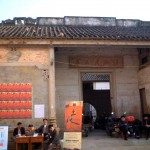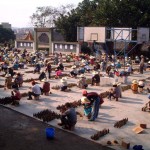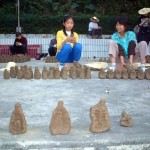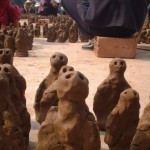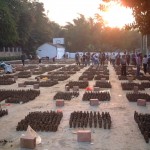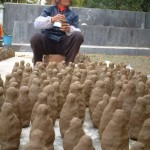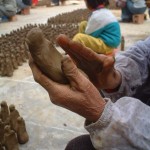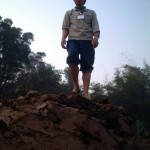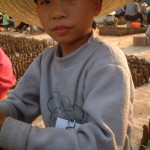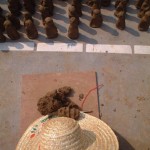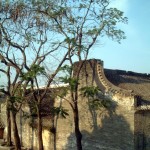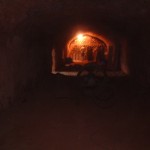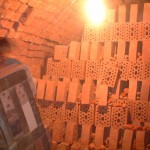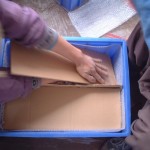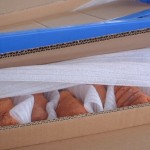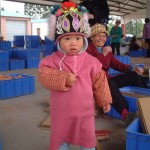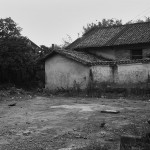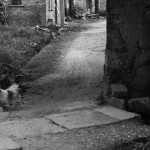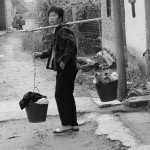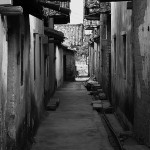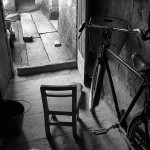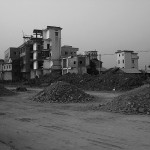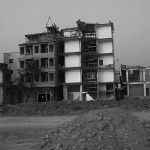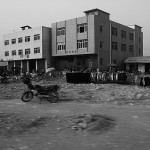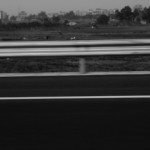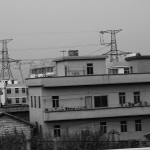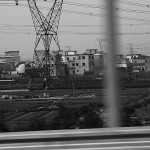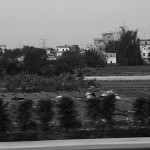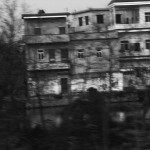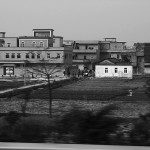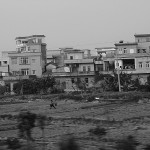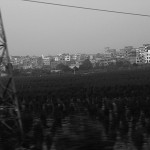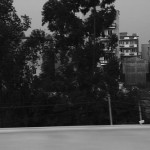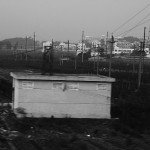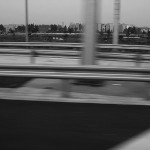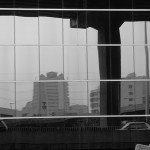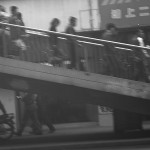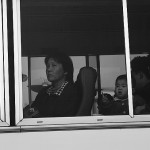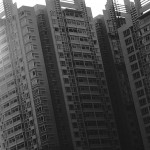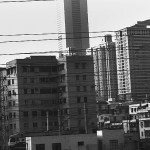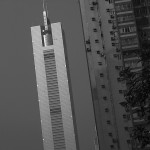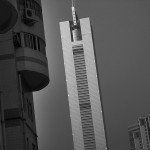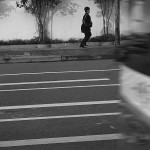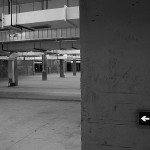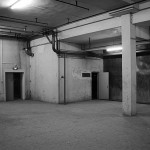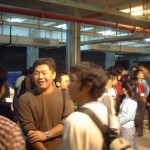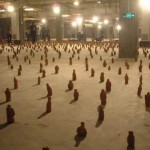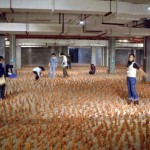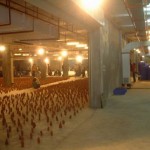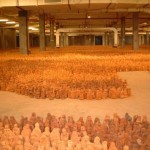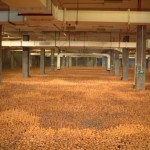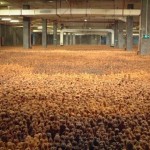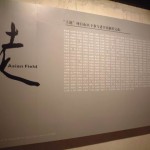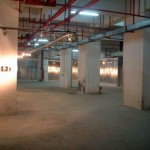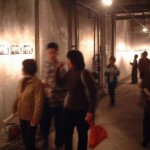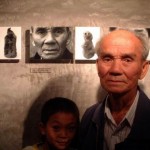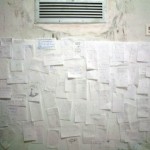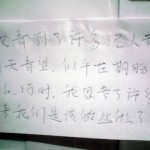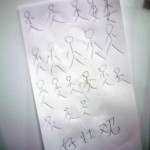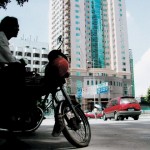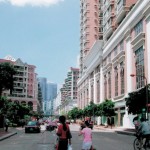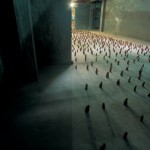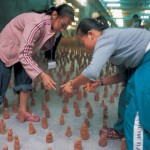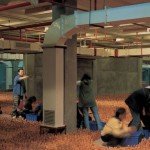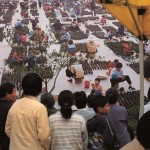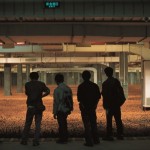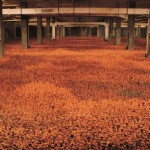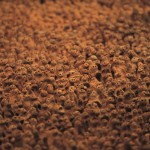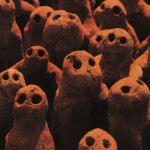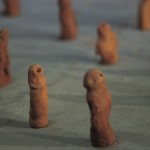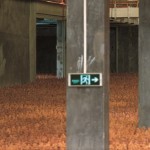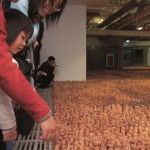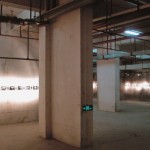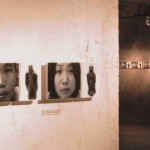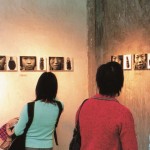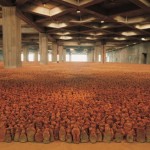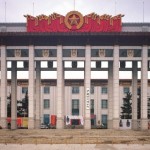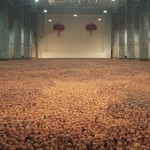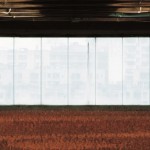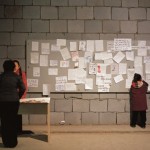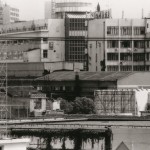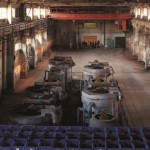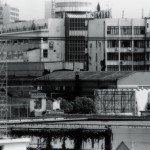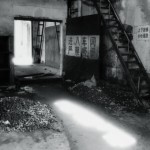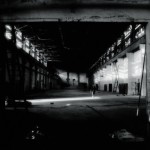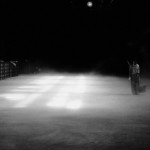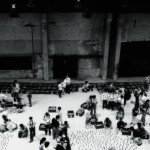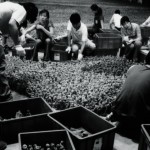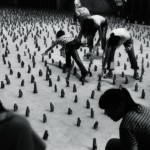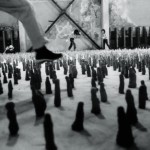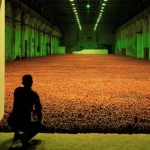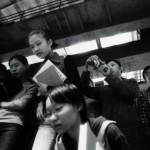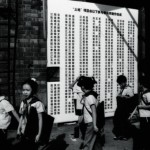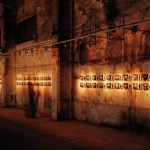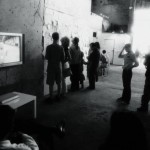About Asian Field
Asian Field exhibition tour is an immense sculptural installation by the eminent British artist Antony Gormley, organised by the British Council, co-organised by vitamin creative space. In this case, Vitamin Creative Space team tries to find the real relationship between Asian Field and Chinese local landscape. The making of this project happened in a small village. From Jan 18-22, more than 200,000 hand sized clay figures were made by almost 400 people of all ages from the Xiangshan village, Huadu District in the north-east of Guangzhou, under the guidance of the artist, Using over 100 tons of clay. The figures took five full days to complete, after which they were fired at a local brick factory. Then all the figures are moving to Guangzhou city.
The exhibition in Guangzhou is opened in an underground car-park in Xinhua Garden, Huajing Xin Cheng. on 22 March 2003, 180,000 figures completely occupy the space in the car-park in which they are shown and can only be viewed from a threshold which cannot be crossed. In effect it is reversing the process of viewing art, for it is the onlooker who is met by thousands of upturned faces returning their gaze. When confronted by the mass of simply formed figures in varying shades of orange, red and brown clay, Field can be seen as a landscape within a room, the transposition of the external into an internal space, stretching as far as the eye can see.
When the exhibition is over in Guangzhou on June 15, the work will tour to Beijing, Shanghai and Chongqing.
The following article describes the making process which happened in Xiangshan village, Huadu District in the north-east of Guangzhou.
Asian Field unnamed
Hu Fang
0
For a long time, I didn’t know how to express my feelings on encountering Asian Field in different cities. As the time and place changed, my feelings often changed too, making it impossible to draw them together, and so I could never find the right words to describe them.
What Asian Field inspires in me is the opposite of calm analysis: an instant, red-hot reaction. It’s like being in a state where names have yet to be given, where a force more powerful than language convinces me that I’m capable of changing form, of flying through the air. Here, rational sentences carry the risk of limiting emotions.
What are words?
Are words a limitation?
What is the relationship between words and emotion?
Is there a limit to emotion?
Perhaps the best way to describe what I feel is to use 365 questions to illuminate the experience of Asian Field over the past year:
Is art something which has to be spoken?
If you speak, is it in order to communicate?
If no communication takes place, does that mean it is not good art?
What do you want to see?
What do you want to say?
Is art those small clay figures standing over there?
Can you describe what you’ve seen?
Are you a part of art?
Are you not art?
Why do some people feel lonely, and some feel happy?
Are you a happy person?
Are your feelings your own feelings?
If there is a correct way of interpreting a work, who defines it?
If there is no correct or incorrect interpretation, then is it up to us how we react?
Is it true that, if we don’t express our feelings, we forget them?
Is it true that without these small clay figures we cannot feel anything?
What is expression?
Is the aim of expression to make things clearer?
What is the meaning of clarity?
Is to identify the same as to express?
1
April 18th, 2003, London.
A sudden attack of respiratory infection delivers me onto the operating table at King’s College Hospital. Thanks to the general anaesthetic, this period of my life becomes a blank. No-one tells me how long the blank lasts. I wake up in the dead of night or the small hours of the morning and find a drip tube inserted into my right arm, and an oxygen tube hissing gently in my nose. I rub my throat, it seems to be still intact. Drowsy from the painkillers, I fall back into a deep sleep.
Two days later, as I watch from the taxi as the hospital gates recede into the distance, and the long forgotten warmth of the sunlight envelops me once more, I can scarcely believe that I’m returning to the world.
For the next two weeks, the wound and the medication keep me confined to my room. I while away the time reading and gazing out of the window at the little garden. One day, during a fitful lunchtime sleep, a hallucinatory vision flashes before me: a huge underground space, filled with echoes at the slightest spoken word; it has the atmosphere of a vast church space, the countless clay figures its protective deities; it’s as though Asian Field has become a sanctuary…
I know that at this moment, these clay figures are actually in a huge underground car park in Guangzhou, waiting silently for visitors to come and inspect them. Yet on the streets outside, people are hurrying home through the dusk, their faces covered in masks. Because of SARS, everyone is now restricting their daily activities to just two venues – home and workplace.
It’s curious that at exactly the time when my body is unable to move, I can travel in spirit to another space, for example the space occupied by Asian Field, and the towns it visits. These become a space and a memory which I can carry with me at all times.
August, Beijing.
I stroll through the surviving lanes of old Beijing, watch the old men playing chess and the peddlers selling their wares. In a lane behind the Drum Tower, I discover to my surprise a little hut built in the branches of a scholar tree; by climbing up a ladder, the parents down below and the young couple in the tree can get together to eat and chat.
I’m always fascinated by this kind of carefree day to day life, fascinated by the transition between daily life and Asian Field.
In the main hall on the first floor of the National Museum of China, 160,000 small clay figures are arrayed, awaiting their encounter with the people…
Visitors catch sight of them after walking up the steps. “It’s like inspecting a military parade on Tiananmen Square,” a friend said to me.
High above the clay figures, the red lanterns of the nation’s founding ceremony only add to this impression…
For Chinese people, Tiananmen Square has long outgrown its geographical limits to become an imagined space in each individual’s mind. When we talk about Beijing, about Tiananmen, what we think of is China, the struggles of its history and the founding of the new China. When Asian Field entered this place, after a journey of a thousand miles from south to north, it immediately became part of the history of a nation…
Every day, tourists from all over the country gather in Tiananmen Square. In front of Chairman Mao’s Mausoleum, people queue up, waiting to pay their respects to his remains.
When I read some of the comments which people have left behind, I find them touching — and thought-provoking. One girl, who came to Tiananmen as a tourist from a small town in the north and came upon Asian Field by chance in the National Museum, wrote emotionally about her love for the motherland. It reminded me of the innocent, glorious illusions of my youth, of that heart-warming song “I love Beijing Tiananmen”.
In this place, Asian Field suddenly seems to have stirred up a powerful collective consciousness.
This space seems to convey and represent a search for some kind of lost values. Face to face with the clay figures, people realize that such values actually still exist, that they are always in people’s hearts.
In this way the space is engaged in a silent dialogue with countless “personal histories”, and becomes a public platform for expressing emotions.
October, Shanghai.
Under the plane trees, an atmosphere of rare calm.
On the Huaihai Road, tall slim models are putting on a performance outside a wedding photography studio.
I think of the phrase “made in Shanghai”. In the past it meant suits made of Dacron. Now it means Xintiandi [1] and the Jinmao Tower [2].
In the old neighbourhoods of stone-gate shikumen houses, they’re still using wooden buckets as toilets.
A city replete with secrets, skilled in the ways of the world; a city so much written about, where material desire is layered upon desire.
For me, Shanghai is more about the overlapping of many private spaces. The silent photographer, the gorgeously dressed girl in the middle of the old alleyway, the staff walking with their heads down through the new office buildings. So many private desires, never quite spoken.
When I turn off the secluded side-street into the exhibition hall – converted from an old factory now fallen silent – I feel as though I have suddenly entered a world of silent desires. In the silence I can hear the sound of my own innermost thoughts; the comments which cover the walls are testimony to the efforts people have made to express these inner feelings…
The old factory building and its contents – the huge machines, the black and white photographs of the makers of the clay figures, the red clay figures themselves — seem to have barged into this sophisticated city, and are now crying out.
Just by looking at the exhibition space itself you can see the confusion of this city in the midst of its breakneck transformation. The old factory building is soon to be demolished and a new commercial centre will rise up in its place. Close by, there’s already a forest of new residential towers, like a distant echo of the venue of Asian Field in Guangzhou – a newly built residential district.
It’s a whirlwind which sweeps up everyone in its path.
To visit Asian Field here is actually to sense the layers of desire which have been buried one beneath the other:the visitors are the tiny details of desire, the city the collective crystallization of desire.
Observing Asian Field becomes a vehicle for travelling beyond the order of everyday life.
Each visitor will return to their own private space, carrying with them the psychological fragments of Asian Field. In Shanghai, by means of these psychological fragments, Asian Field has been inlaid into the city’s dazzling vision of desire.
Asian Field will become this city’s private space for pouring forth emotions.
November, Chongqing.
In the depths of night, at Chaotianmen harbour, quietly watching the great river flowing east…
There’s a touch of winter in the air, immediately driven away by the boiling Chongqing hotpot. The red flavourings of the hotpot sauce seethe in the bubbling water like lava in a volcano. Their redness forms a stark contrast with the greyness of the city.
By the Liberation Monument, there’s a great crowd of people, the front of the Metropolitan Plaza is ablaze with lights, people’s faces brim with an unnamed excitement – here the colour is red too. The ranks of skyscrapers on the hill have sketched a new expression on the face of this city — a coarsely outlined vitality.
Here Asian Field has been placed on the top floor of a shopping centre. It’s the only venue in any of the four cities which has an open background. When the weather is fine, visitors can see through the floor-to-ceiling glass windows behind the clay figures to the scene beyond: tall buildings, advertising hoardings. Of course, since it’s winter, the background is still grey most of the time.
After looking at the clay figures, many people stand at the window of the information centre and gaze down on the city below.
In this location Asian Field seems even more like a space for contemplation in the middle of the material world, just a wall’s width away from all the bustle and hubbub. Perhaps they are not so inseparable…
At this final point on the tour of China, I make the surprising discovery that Asian Field has been absorbed into that aspect of Chinese daily life where the “shopping centre” has replaced the “People’s Square”, and at one bound has become the true centre for people’s entertainment, leisure and cultural activities. “It’s an irresistible floodtide – beyond it is nothing but the boundless black night.” [3]
The vast circular gallery where the pictures of the makers of the clay figures are on display seems to provide an echo of the visitors’ deep contemplation. It’s like standing shouting into a valley, and hearing your words repeating ceaselessly in the distance: “hi, hi, hi.”
I think of my trip to see the stone carvings at Dazu [4]; I was so touched by those statues with the broken heads, yet whose souls seemed only the more visible.
“The late rays of sunlight slip through the deep woods, and gleam again on the dark green moss.” [5]
I feel that the chords which tie us to history have still not been severed.
On another occasion, I go in search of the last few old residential areas of the city. From the top of Shiban Hill I gaze across the river to the hazy vista of the opposite bank.
Perhaps the flowing waters of the river can bring us new enlightenment.
Back to Guangzhou, back to May: even though at this time everyone takes fright at the mere mention of SARS, there is still a constant stream of people coming to see Asian Field, leaving their comments and joining in the debate. On the afternoon of June 15th, the final day of the exhibition, a crowd gathers in the underground exhibition space to hear a concert specially devised for Asian Field by Wang Lei and his band. I never expected so many people to come; everyone listens and watches very calmly. There’s a sweet sense of a post-SARS return to normality; it feels even more surreal than the dream I had that afternoon in London…
0
Just as Asian Field possesses a great flexibility in regard to the space it occupies, so my search for Asian Field in the different exhibition spaces in each city became a secret pleasure.
It was Asian Field which linked my travels from city to city — as though I had discovered a private passageway which traversed conventional boundaries…
Apart from being certain that Asian Field really existed in different physical spaces, that it affected and passed through many different inner worlds — none of which exist in isolation; apart from being certain that, one day, the clay figures will disappear, my words will disappear, all the responses will disappear, but people will still, at some point in their lives, suddenly think of their encounter with that spiritual space; apart from being certain that, even if one’s feelings on encountering this work cannot be named, have never been put into words, people nevertheless did all they could to express them, to describe and to listen… Apart from all these things, I cannot be sure of anything more.
If we have not been named, “we all belong to each other.” [6]
Translated by Duncan Hewitt
[1] A luxury pedestrian shopping zone
[2] At eighty eight storeys China’s tallest building].
[3] “Shopping Utopia”, Hu Fang, Bleu de Chine, Paris, 2002
[4] A famous area of Buddhist carvings, south of Chongqing.
[5] From a poem by the famous Tang dynasty poet Wang Wei.
[6] Song lyric by Wang Lei.
